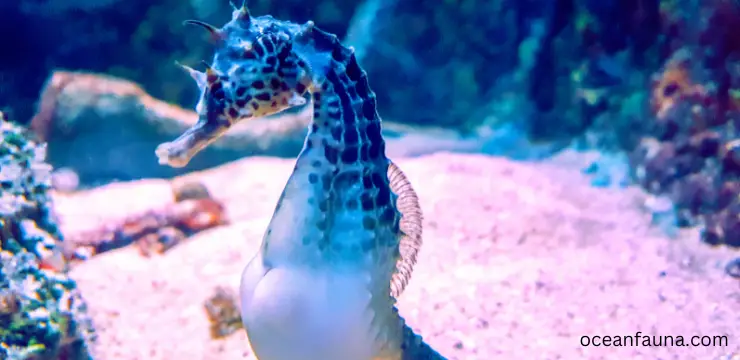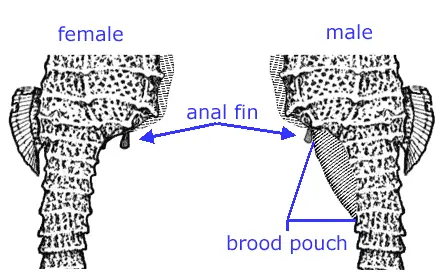Yes, Male seahorses give birth to offsprings just like females. The truth is- female seahorses produce the eggs and male seahorses take the responsibility of carrying these eggs in their (male) pouch that can hold hundreds of eggs.
They provide the same kind of care for their eggs in the pouch mothers provide in the uterus. This article merely talks about the most-asked queries about male seahorses and why they give birth to their babies.
We will provide factual information and expert opinions on the topic. Let’s meet this special creature, “The male seahorse,” and learn more about it.
Do Male Seahorses Give Birth? Lets’ Be Straightforward
Yes, male seahorses give birth. The popular myth about “male seahorse pregnancy” has been around for many years and as a result, the seahorse image has been damaged.
However, some zoos keep a male seahorse with his brood pouch because the animal is very protective and does not tolerate human contact.
But even though there is no solid evidence of their mating and reproduction, it is interesting to know a little about them so let’s learn a little about these unusual animals. Why the male seahorses have more responsibility for their eggs than their female counterparts? Let’s take a deeper look at it.
Why Do They Give Birth?
Male seahorses (and their close cousins) are the only male animals in the animal kingdom who give birth to offspring, although this does not mean they become pregnant. But the question is why they are so different in the reproductive cycle.

Do Male Seahorses Get Pregnant and Give Birth?
Male seahorses only carry the eggs and give birth at due time; they do not produce offspring. Male and female seahorses court before the female lays eggs in the male’s pouch. When the male is ready, he will go into the pouch and fertilize the eggs. Instead of a uterus, like in humans, seahorse fathers use a pouch to nurture their young.
Their pouch controls the environment in which their eggs develop, including temperature, blood flow, and saltiness. Wow, that’s a lot of cute little seahorses! The male seahorse also uses energy-intensive muscular contractions to give birth, just like human mothers.
Energy And Responsibility Exchange
Seahorses are classified as members of the family Syngnathidae. Only the male seahorse has a genuine pouch where the maturing eggs are kept. They also provide oxygen and nutrition to their offspring through a placenta-like link.
Scientists have hypothesized that males in the family Syngnathidae have evolved to carry babies, which speeds up the reproductive process. There would therefore be a greater possibility of the species’ survival.

The mother can lay more eggs while the male carries the young. Then, shortly after the male gives birth, she can implant the eggs. It appears that this strategy shares the energy expenses of reproduction more fairly between the sexes.
While male seahorses may not win any prizes for “best dad,” they should be recognized for being the only male creatures ever to be entrusted with caring for eggs in a pouch and giving birth. But keep in mind, it doesn’t mean they are pregnant.
Thus, seahorses may have developed this way to help the species survive, but scientists don’t know why. The fact is parents do not raise baby seahorses. They’re alone after the father gives birth. They would have to live on their own.
How Do Female Seahorses Transfer Eggs?
Seahorses engage in a lengthy courtship dance, complete with colorful displays of virility from both sides, before they settle down with a partner. To mate, the male and female must rise out of the water so that the female’s ovipositor may connect with the male’s pouch opening.
The female will place anywhere from a handful of eggs to a large clutch into the male’s brood pouch. Embryos implant themselves in the brood pouch tissue of the male, where a placental fluid circulates through a system of capillaries to supply them with nutrients and oxygen.
It seems that the adult male’s nutrition changes as the embryo develop. So, the male’s modified skin abdominal pouch receives the female’s eggs. As the eggs enter, the male fertilizes them with sperm and incubates them for 24 days. This is how female seahorses transfer eggs.
How Long Are Seahorses Pregnant?
Seahorses’ pregnancy lasts 15 to 30 days or until they are born. It depends on water and other factors like temperature, oxygen, etc. The young seahorses may start to appear as early as two weeks after fertilization. They are born fully developed.
By the time the young seahorses are four weeks old, their young begin to swim. However, they are still immature and need the company of their parents to develop properly. It’s fascinating to watch the baby seahorses swimming with their parents. However, it’s not common in seahorses.
How Do Seahorses Give Birth?
A seahorse’s pregnancy and birth process are unlike other sea creatures and humans. When it’s time to give birth, the male goes through a process similar to contractions, which he uses to force his brood pouch open and his offspring into the water.
The male appears to be repeatedly moving forward and then backward during the process of giving birth. It only takes a few hours for the male’s brood pouch to return to its usual size once he has released his young babies, allowing him to start incubating his partner’s eggs again.
Does It Hurt When a Male Sea Horse Gives Birth?
Yes, it hurts a seahorse to give birth. Experiencing labor pains is real; yes, it can happen to a man. While the embryos are developing, he supplies them with oxygen and controls the salinity, so there is no difference between the pouch and the outside environment. He’s experiencing contractions strikingly comparable to those observed during human labor.
The seahorse father does nothing for his offspring once they are born. Due to the lack of parental supervision, youngsters are on their own to fend off potential threats and keep themselves safe. Father seahorses typically don’t eat for a few hours after their offspring are born.
The duration of labor might vary from just a few hours to several days. Even when he is exhausted and sick from having just given birth, a man will not wait long before he begins pursuing the woman again.
We can’t measure the “pain” a male seahorse could experience during delivery, but our best estimate is that it varies from species to species (their age, whether this is their first batch, etc.). A few days after giving birth, the male will start the mating and gestation cycle again.
How Many Babies Can a Seahorse Have?
A seahorse can have as many babies as 2000 at a time. Because of this incredible fact, seahorses are among the creatures with the highest reproductive rate but a low survival rate.
Interestingly, only a few survive out of thousands of babies. Fathers abandon their offspring after delivery, and neonates have a 0.5% chance of reaching maturity or surviving adulthood.
Does A Male Seahorse Die After Giving Birth?
No, a male seahorse does not die right after giving birth. It means it’s not the fact that they die after giving birth or because they care for the young.
It means that the father is deeply committed to raising the babies and will do anything to protect the young from threats, most notably other seahorses, fish, humans, etc.
He’s extremely aggressive in his defense of his young. They die in several ways: their skin tears, their limbs are crushed, etc. They do not die due to the reason for giving birth or because they are at the end of their life. They die whenever death comes calling.
What Happens If a Seahorse’s Mate Dies?
There is love in the ocean, too, not only on land. The sea horses are a fantastic symbol of this adoration. Sea horses are adorable in their own right, but they also have the words “love and romantic” tattooed across their foreheads. It’s been observed that seahorses form lifelong bonds with their partners.
In contrast to the vast majority of fish species, seahorses are monogamous (they only mate with one other seahorse for their whole lifetimes) and remain wed for their entire existence, as reported by National Geographic.
Love is supposedly the cause of death for seahorses. Due to their mutual dependence, when one seahorse dies, the other usually follows soon after. Marine equines represent love, harmony, and togetherness.
Their unusual courtship rituals involve dancing, showing vivid colors, swimming side by side, and rotating around one another. It’s very sweet!
Conclusion
Male seahorses do not give birth, and they do not get pregnant. They only share responsibilities and give birth to the babies after caring for the eggs in their pouches. Baby seahorses likely have all the food they need from their parents. This makes a seahorse “the best and most responsible dad” since it contributes to the survival of its babies.
Learning more about the seahorse’s unique family life is interesting but also scary. I hope you enjoyed the article!


7 thoughts on “Do Male Seahorses Give Birth? The Biological Insight”